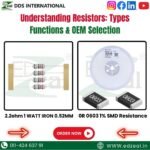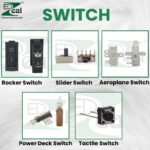How to Select the Right Resistor: Types Tolerances & OEM Insights

Understanding Resistors: Types, Functions & OEM Selection

What Is a Resistor?
A resistor is a two-terminal passive component that opposes current flow. By converting electrical energy to heat, it stabilizes voltages, limits current, and shapes signals. Its value is measured in ohms (Ω), with common series like E6, E12, and E24 providing standard increments for design.
Core Functions in Real Circuits
- Current Limiting: Protect LEDs, ICs, and sensors from overcurrent.
- Voltage Division: Create reference levels for ADCs, comparators, and bias networks.
- Bias & Stability: Set operating points in transistor and op-amp stages.
- Filtering & Timing: Combine with capacitors/inductors for RC time constants and signal conditioning.
- Sense & Feedback: Low-ohm shunts measure current for control loops.
Tip: For precision dividers, match temperature coefficients (TCR) and use tight tolerance pairs to maintain ratio accuracy over temperature.
Main Resistor Types (and When to Use Them)
Carbon Film
General-purpose, economical. Suitable for basic consumer electronics where tolerance and noise aren’t critical.
- Typical tolerance: ±5%
- Use in low-cost, non-precision stages
Metal Film
Low noise and tighter tolerance—great for precision analog, instrumentation, and audio paths.
- Tolerance: ±1% (or better)
- Lower TCR improves stability
Wire-Wound
High power handling and excellent pulse endurance. Common in power supplies, motor drives, and load banks.
- Can be inductive—avoid in high-frequency signal paths
- Choose non-inductive variants for fast switching
SMD (Chip Resistors)
Compact, automated assembly, wide value/power range. Backbone of modern mass production.
- Packages: 0201–2512 (and larger for power)
- Consider pad design for heat spreading
Variable (Potentiometers/Trimmers)
Adjustable resistance for calibration, volume, and tuning. Available in through-hole and SMD trims.
- Specs: track material, life cycles, wiper resistance
- Seal type matters for flux/cleaning processes
Specialty (Shunt, Fusible, Anti-Surge)
Designed for measurement or protection. Shunts for current sense; fusible and anti-surge for safety and inrush.
- Check surge profile and fusing behavior
- Validate creepage/clearance in mains designs
How to Select the Right Resistor
| Parameter | Why It Matters | OEM Guidance |
|---|---|---|
| Resistance Value (Ω) | Sets current/voltage; affects noise and power loss | Use E-series values; simulate with tolerances & temp |
| Power Rating (W) | Ensures thermal safety at worst-case dissipation | Add 50–100% margin; check airflow & copper area |
| Tolerance (%) | Determines accuracy of dividers/bias networks | Analog paths prefer ±1% or better; ratio match matters |
| Temperature Coefficient (ppm/°C) | Stability over operating temperature | Pick low TCR for references and sensors |
| Voltage Coefficient / Max Working V | High voltages can shift resistance | Check datasheets for HV dividers and feedback paths |
| Pulse/Surge Performance | Survives inrush, ESD, or load transients | Use anti-surge or wire-wound where needed |
| Package & Footprint | Impacts assembly yield and reflow profile | Standardize sizes (0603/0805/1206/2512) across SKUs |
Thermal tip: In SMD power resistors, enlarge copper pads and consider thermal vias to lower hotspot temperatures and extend life.
Where Resistors Show Up (Every Day)
- Chargers & Power Supplies: Start-up, snubbers, bleeders, and feedback dividers.
- LED Lighting: Current limiting for indicators, strips, and drivers.
- Industrial Controls: Sense resistors in motor and PSU control loops.
- Audio & Instrumentation: Precision metal-film for low noise and drift.
- Automotive: Load simulation, lighting, and sensor interfaces.
Common Pitfalls (and Easy Fixes)
- Underrated Power: Parts run hot and drift—add margin and copper area.
- Ignoring TCR: Precision ratios wander with temperature—spec low TCR and matched pairs.
- Wrong Package for Rework: Ultra-small sizes are hard to service—choose 0603/0805 where field repair matters.
- Inductance in Fast Paths: Wire-wound can ring—use non-inductive or thick-film for HF.
Need Production-Ready Resistors?
We supply SMD chip resistors, metal-film precision parts, power wire-wound, shunts, trimmers, and anti-surge options with steady stock, ROHS/REACH docs, and technical guidance for design-in.Browse Resistors Request Bulk Quote



